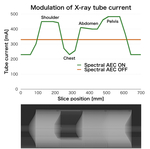Background/introduction
In the conventional dual-energy CT (DECT) imaging with rapid-kV switching, automatic exposure control (AEC) cannot be used [1] due to limitations of hardware and software. Other DECT acquisition systems such as dual-layer detector CT or dual-source CT can perform the AEC, however, their hardware cost is generally higher than the rapid-kV switching system. If AEC is not available, an optimal radiation dose cannot be delivered to each body portion, especially in a wide range CT scan such as the chest and abdomen. It may result...
Description of activity and work performed
Body Phantom
We made a body phantom simulated from shoulder to pelvis using 3D printer (Agilista 3200, KEYENCE, Osaka, Japan). As shown in Fig. 3 , the cross-section of the phantom was 30 x 20 cm, and the length was 60 cm. X-ray transparency was adjusted by content fluid to simulate each region. The shoulder was filled with 3 mgI/ml diluted iodine contrast medium, backside of the chest was partially filled with water, the abdomen was filled by water, and the pelvis was filled with...
Conclusion and recommendations
In conventional rapid kV switching DECT imaging, there is a possibility that excessive radiation exposure may occur because AEC cannot be applied. A new rapid kV switching DECT method using deep learning can apply the AEC, suggesting the possibility of homogenizing the image quality of whole-body DECT examinations and optimizing radiation exposure.
Personal/organisational information
T. Higaki; Hiroshima/JP - nothing to disclose Y. Nakamura; Hiroshima/JP - nothing to disclose F. Tatsugami; Hiroshima/JP - nothing to disclose Y. Honda; Hiroshima/JP - nothing to disclose C. Fujioka; Hiroshima/JP - nothing to disclose K. Awai; Hiroshima/JP - Research/Grant Support at Canon Medical Systems
References
Shepard J-AO (2018) Thoracic Imaging The Requisites E-Book. Elsevier Health Sciences





